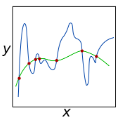Studies involving both randomized experiments as well as observational data typically involve time-to-event outcomes such as time-to-failure, death or onset of an adverse condition. Such outcomes are typically subject to censoring due to loss of follow-up and established statistical practice involves comparing treatment efficacy in terms of hazard ratios between the treated and control groups. In this paper we propose a statistical approach to recovering sparse phenogroups (or subtypes) that demonstrate differential treatment effects as compared to the study population. Our approach involves modelling the data as a mixture while enforcing parameter shrinkage through structured sparsity regularization. We propose a novel inference procedure for the proposed model and demonstrate its efficacy in recovering sparse phenotypes across large landmark real world clinical studies in cardiovascular health.
翻译:涉及随机实验和观测数据的研究通常都涉及时间到活动的结果,如故障时间、死亡或不利条件的开始等,这些结果通常会因后续行动的丧失而受到审查,既定的统计做法涉及在治疗组和控制组之间的危险比率方面对治疗效率进行比较。在本文件中,我们提出了一种统计方法,以恢复表明与研究组相比有不同待遇影响的稀有类(或亚型)的统计方法。我们的方法是将数据作为混合物进行模拟,同时通过结构化的封闭性规范来实施参数缩缩缩。我们为拟议的模型提出一个新的推论程序,并表明其在大型具有里程碑意义的心血管健康世界临床研究中恢复稀有型(或亚型)的效果。</s>



